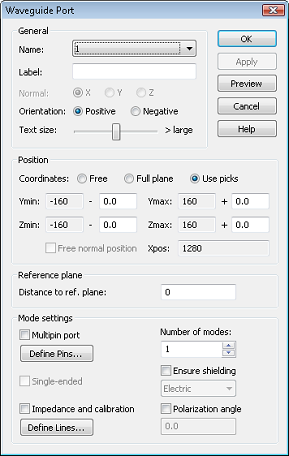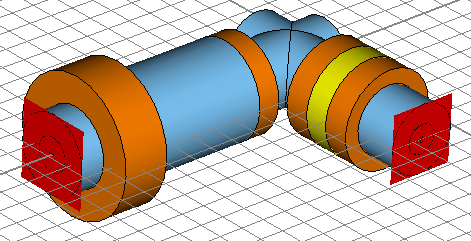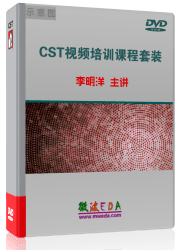- 您現(xiàn)在的位置: 微波EDA網(wǎng) >> CST >> CST設(shè)計(jì)實(shí)例 >> 正文
CST同軸線器件的仿真設(shè)計(jì)分析—CST2013設(shè)計(jì)實(shí)例
Common Solver Settings
To this point, only the structure itself has been modeled. Now it is necessary to define some solver-specific elements. For an S-parameter calculation, you need to define input and output ports. Additionally, the simulation needs to know how the calculation domain should be terminated at its bounds.
Define Ports
Each port that is defined will simulate an infinitely long waveguide (here a coaxial cable) that is connected to the structure at the ports plane. Waveguide ports are the most accurate way to calculate the S-Parameters of filters and should therefore be used in this case.
Since a waveguide port is based on the two dimensional mode patterns in the waveguides cross-section, the port must be defined large enough to entirely cover these mode fields. In the case of a coaxial cable, the port has to completely cover the coaxial cables substrate.
Before you continue with the port definition, please clear the selection by either double-clicking on the views background or selecting Components in the navigation tree.
The ports extent can be defined either numerically or, as is more convenient here, by picking the face to be covered by the port. Therefore, activate the general pick tool (Modeling: Picks > Picks > Pick Point, Edge or Face (S)) and double-click the substrates port face at the first port as shown in the picture below:

Please open the waveguide dialog box (Simulation: Sources and Loads > Waveguide Port ) to define the first port 1:

Whenever a face is picked before the port dialog is opened, the ports location and size will automatically be defined by the picked faces extent. Thus the ports Position (transversal as well as normal) is initially set to Use picks. You can accept this setting. The next step is to choose how many modes should be considered by the port. For coaxial devices, we usually have only a single propagating mode. Therefore, you should simply keep the default of one mode.
Finally, check the settings in the dialog box and press the OK button to create the port:

Now you can repeat the same steps for the definition of the second port:
1. Pick the corresponding substrates port face (Modeling: Picks Picks Pick Point, Edge or Face (S)).
2. Open the waveguide dialog box (Simulation: Sources and Loads Waveguide Port .)
3. Press OK to store the ports settings.
Your model including the ports should now look as follows:

-

CST中文視頻教程,資深專家講解,視頻操作演示,從基礎(chǔ)講起,循序漸進(jìn),并結(jié)合最新工程案例,幫您快速學(xué)習(xí)掌握CST的設(shè)計(jì)應(yīng)用...【詳細(xì)介紹】
- CST天線設(shè)計(jì)和天線陣設(shè)計(jì)—CST2013設(shè)計(jì)實(shí)例
CST諧振腔體設(shè)計(jì)分析—CST2013設(shè)計(jì)實(shí)例
使用CST微波工作室進(jìn)行TDR計(jì)算分析
CST與Matlab連接設(shè)置
CST微波工作室和Agilent ADS 協(xié)同仿真連接設(shè)…
CST微波工作室查看VSWR結(jié)果
CST仿真分析結(jié)果如何與外部數(shù)據(jù)進(jìn)行比較
CST微波工作室采用的主要算法
使用CST微波工作室的時(shí)域求解器仿真電大問題…
電磁兼容的數(shù)值仿真分析——CST2013
CST仿真性能和仿真技術(shù)
CST設(shè)計(jì)環(huán)境 — CST2013
推薦課程
-
7套中文視頻教程,2本教材,樣樣經(jīng)典
-
國內(nèi)最權(quán)威、經(jīng)典的ADS培訓(xùn)教程套裝
-
最全面的微波射頻仿真設(shè)計(jì)培訓(xùn)合集
-
Ansoft Designer 學(xué)習(xí)培訓(xùn)課程套裝
首套Ansoft Designer中文培訓(xùn)教材
-
矢網(wǎng),頻譜儀,信號(hào)源...,樣樣精通
-
與業(yè)界連接緊密的課程,學(xué)以致用...
-
Les Besser射頻培訓(xùn)經(jīng)典原版視頻
業(yè)界大牛Les Besser的培訓(xùn)課程...
-
PCB設(shè)計(jì)學(xué)習(xí)培訓(xùn)課程套裝
Allegro,PADS,PCB設(shè)計(jì),其實(shí)很簡單..
-
Hyperlynx,SIwave,助你解決SI問題
-
現(xiàn)場講授,實(shí)時(shí)交流,工作學(xué)習(xí)兩不誤






